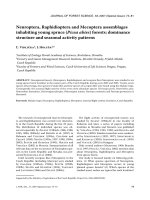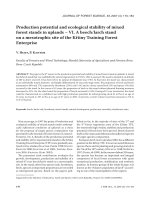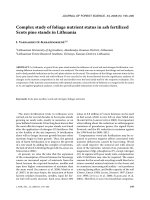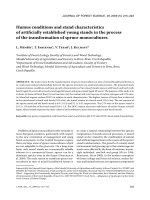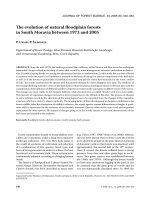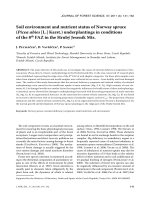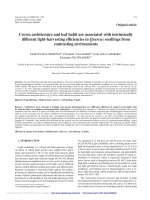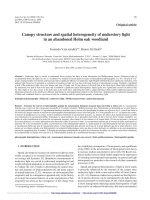Báo cáo lâm nghiệp: "Precipitation partitioning and related nutrient fluxes in a subtropical forest in Okinawa, Japan" ppt
Bạn đang xem bản rút gọn của tài liệu. Xem và tải ngay bản đầy đủ của tài liệu tại đây (270.21 KB, 8 trang )
245
Ann. For. Sci. 62 (2005) 245–252
© INRA, EDP Sciences, 2005
DOI: 10.1051/forest:2005016
Original article
Precipitation partitioning and related nutrient fluxes
in a subtropical forest in Okinawa, Japan
Xiaoniu XU
a,b,c
*, Qin WANG
a,b
, Eiji HIRATA
b
a
Department of Forestry, Anhui Agricultural University, Hefei, Anhui 230036, P.R. China
b
Faculty of Agriculture, University of the Ryukyus, Nishihara, Okinawa 903-0213, Japan
c
Present address: Field Science Center for Northern Biosphere, Hokkaido University, Nayoro, Hokkaido 096–0071, Japan
(Received 15 April 2004; accepted 31 August 2004)
Abstract – Precipitation partitioning into throughfall and stemflow and related hydrochemical fluxes were examined during a 3 y period from
January 1998 to December 2000 in a subtropical evergreen broad-leaved forest on Okinawa Island, Japan. Monthly water samples were
collected to determine the concentrations and associated fluxes of bioelements. The mean annual precipitation during the study period was
3325 mm. Typhoons played a central role in the hydrology of the study forest with 11 typhoons contributing 29.1% of the total rainfall over the
3 y period. Throughfall and stemflow contributed 53.9% and 30.9% of the annual rainfall, respectively, implying a rainfall interception of
15.2%. The very high fraction of stemflow could be due to the crown morphology of the dominant species, Castanopsis sieboldii, that has
inclined branches and concave shaped leaves. Mean pH in the precipitation was 6.22, and decreased significantly as the water passed through
the canopy. Concentrations of total N, DOC, K, Na, Ca, and Mg showed a clear pattern of enrichment in both throughfall and stemflow
compared to rainfall. The proximity to the Pacific Ocean strongly influenced the nutrient fluxes via rainfall at our site as illustrated by the
extremely high Na fluxes via rainfall (213 kg Na ha
–1
y
–1
) and throughfall plus stemflow (291 kg Na ha
–1
y
–1
). The mean annual nutrient inputs
(in kg ha
–1
) were: total N 43, P 2.6, K 76, Ca 49, Mg 30, Na 291, Al 1.8, Fe 1.0, and Mn 1.1. The input of DOC reached 361 kg C ha
–1
y
–1
. The
high nutrient inputs via net precipitation (throughfall plus stemflow) especially for N at our site is thought to reflect the frequent occurrence of
sea salt-induced stress and serious herbivory by insect.
Castanopsis sieboldii / dissolved organic carbon / evergreen broad-leaved forest / nutrient cycling / stemflow / throughfall
Résumé – Partition des précipitations et flux de nutriments dans une forêt subtropicale d’Okinawa au Japon. La partition des
précipitations entre eau arrivant directement au sol et écoulement le long des troncs et flux hydrochimiques liés a été étudié pendant 3 ans de
janvier 1998 à décembre 2000 dans une forêt feuillue à feuilles persistantes de l’île d’Okinawa au Japon. Mensuellement des échantillons d’eau
étaient collectés pour déterminer les concentrations et les flux des bioéléments. Les précipitations annuelles moyennes pendant la période
étudiée ont atteint 3325 mm. Les typhons jouent un rôle central dans l’hydrologie de la forêt étudiée avec 11 typhons contribuant à 29,1 % des
précipitations totales pour les 3 ans de la période d’étude. L’eau arrivant directement au sol et l’écoulement le long des troncs représentent
respectivement 53,9 % et 30,9 % des précipitations incidentes annuelles, impliquant une interception des précipitations de 15,2 %. La part
importante de l’écoulement le long des troncs pourrait être dû à la morphologie des couronnes de l’espèce dominante Castanopsis sieboldii qui
a des branches inclinées et des feuilles de formes concaves. Le pH des précipitations incidentes était de 6,22, il baissait significativement avec
la traversée de l’eau à travers les couronnes. Les concentrations totales de N, DOC (carbone organique dissous), K, Na, Ca et Mg montrent un
modèle évident d’enrichissement au niveau de l’eau traversant directement les couronnes et de l’écoulement le long des troncs comparativement
aux précipitations incidentes. La proximité de l’Océan Pacifique influence fortement lees flux de nutriments dans le site étudié comme le montre
les flux élevés de Na apportés par les précipitations incidentes (213 kg Na ha
–1
an
–1
) et l’eau arrivant directement au sol et l’écoulement le long
des troncs (291 kg Na ha
–1
an
–1
). La moyenne annuelle des apports de nutriments était de (en kg ha): N total 43, P 2,6, K 76, Ca 49, Mg 30,
Na 291, Al 1,8, Fe 1,0 et Mn 1,1. L’apport de DOC a atteint 361 kg de carbone par hectare et par an. L’apport élevé de nutriments par l’ensemble
des précipitations arrivant au sol (eau traversant directement plus écoulement le long des troncs) particulièrement en ce qui concerne N peut
être le reflet des stress induits par l’eau salée et les insectes herbivores.
Castanopsis sieboldii / carbone organique dissous / forêt feuillue à feuilles persistantes / cycle des nutriments / écoulement le long des
troncs / eau arrivant directement au sol
1. INTRODUCTION
Nutrient inputs and outputs are directly related to the mag-
nitude of the fluxes of water moving into and out of ecosystems,
resulting in an additional transfer of nutrients with different
components [15, 35]. The chemistry of bulk precipitation can
be changed considerably after passing through forest canopy
to the ground [35]. Nutrient concentrations in throughfall and
* Corresponding author: ;
246 X. Xu et al.
stemflow are modified mainly through the processes of wash-
off of materials deposited during the previous period without
rain, and by leaching of nutrient from plants, and absorption of
ions from the rain [34, 36]. The actual nutrient balances depend
on forest type, rainfall excess and soil types and may reflect dif-
ferent patterns of behavior in nutrients in different ecosystems
[5, 8, 24, 30].
There is considerable information on biogeochemical fluxes
for temperate forests in Japan [20] but much less is known about
this aspect for the subtropical forests on Okinawa Island, south-
western Japan. Overall, the understanding of biogeochemical
cycling in tropical and subtropical forests is still relatively poor
compared with temperate forests [6, 42].
Okinawa Island, especially in its northern part, is mainly
covered by evergreen broad-leaved native forest dominated by
Castanopsis sieboldii Hatusima ex Yamazaki & Mashiba
(Fagaceae) and Schima wallichii Kort. (Theaceae). This forest
is considered to have great structural complexity, as well as con-
siderable functional and biological diversity [19, 45]. There-
fore, sustainable management for this forest has been identified
as a priority for research [19]. The main objective of this study
is to determine: (1) precipitation and redistribution processes;
(2) changes in precipitation chemistry during the transfer of
solutions within the canopy; and (3) annual nutrient fluxes by
rainfall. This study provides basic information on the behavior
of the water balance and nutrient cycling in the subtropical for-
est on Okinawa Island.
2. MATERIALS AND METHODS
2.1. Study site
The study site is located in the Yona Experimental Forest of the
University of the Ryukyus (26° 45’ N and 128° 10’ E; Fig. 1). The exper-
imental plot situated in hilly terrain on an upper slope (24) facing N 65° W
at an altitude of 260 m asl. The highest peak, Mt. Yonaha, is 498 m
asl. Trees with DBH greater than 3.0 cm were found at a density of
6625 stems ha
–1
. The total basal area was 45 m
2
ha
–1
, of which the
canopy dominants, C. sieboldii and S. wallichii, contributed 78% of
the total (Tab. I).
The study area has a maritime subtropical climate with abundant
rainfall. Long-term (1963–1996) mean annual precipitation in the area
Figure 1. Location of the study site.
Table I. Basic characteristics of the sampling stand (DBH ≥ 3.0 cm).
Species composition
DBH (cm) Height (m) Density Basal area
Mean Range Mean Range Stems % cm
2
%
Castanopsis sieboldii 11.3 4.2–29.7 9.2 7.5–11.5 225 37.4 25083 59.9
Schima wallichii 14.0 9.8–32.2 10.1 8.5–12.5 41 6.8 7355 17.6
Daphniphyllum glaucescens 7.8 3.1–10.6 7.3 3.8–8.5 38 6.3 2259 5.4
Rapanea neriifolia 4.4 3.0–6.7 5.2 3.5–6.8 68 11.3 1296 3.1
Elaeocarpus japonicus 6.2 3.6–8.6 6.5 5.3–8.2 32 5.3 1179 2.8
Cinnamomum doederleinii 5.5 4.2–7.7 7.2 5.6–8.3 41 6.8 1098 2.6
Ilex liukiuensis 4.9 3.9–9.1 6.2 4.4–7.5 41 6.8 909 2.2
Rhaphiolepis indica 7.4 6.7–15.7 7.0 5.6–8.7 11 1.8 558 1.3
Syzygium buxifolium 4.5 3.1–6.5 5.2 3.8–7.6 29 4.8 549 1.3
Myrica rubra 13.6 11.6–15.9 8.0 7.8–8.6 5 0.8 382 0.9
Persea thunbergii 9.1 8.1–12.3 10.0 9.5–10.8 5 0.8 206 0.5
Others (15 species) 4.2 3.0–8.7 5.3 3.3–8.2 66 11.0 1017 2.4
Total 602 100 41891 100
Water and related nutrient fluxes 247
is 2680 mm y
–1
, with an annual maximum of 3982 mm y
–1
in 1969 and
an annual minimum of 1905 mm y
–1
in 1977. Mean annual pan evapo-
ration is about 1600 mm y
–1
. The annual mean temperature is 21.6 °C,
with January and July being the coldest and hottest months, with tem-
peratures averaging 5.4 °C and 34.5 °C, respectively (Yona Experi-
mental Forest, University of the Ryukyus). Typhoons occur frequently
between July and October, bringing high rainfall and strong winds to
the island.
The soil of the study site has a clay loam texture, and has developed
from Palaeozoic clay-slate, with acid characteristics. Soil pH is 4.1.
Concentrations of total organic C and total N are 72.5 and 3.6 g kg
–1
.
Exchangeable cations are: K
+
0.61, Ca
2+
3.01, Mg
2+
1.44 cmol(+) kg
–1
,
respectively, in the top 10 cm mineral horizon [46]. This soil type cor-
responds to a Typic Paleudults according to the USDA classification [40].
2.2. Hydrological measurements
At the study site, a representative plot of 30 m × 30 m was delim-
ited. Rainfall, throughfall and stemflow solutions were collected once
or twice a month from January 1998 to December 2000. Rainfall was
collected in two rain gauges situated 1.5 m above the ground in a clear-
ing (about 20 m × 20 m) on a flat ridge adjacent (about 50 m distant)
to the experimental plot. Throughfall was collected with four PVC gut-
ters (each with a collecting area of 0.4 m
2
, i.e. 20 cm × 200 cm) situated
at a height of 1.0 m with the flow passing into self-empty, tipping
bucket with one empty of 500 mL, and then the solution was chan-
nelled into polyethylene containers of 20 L. Stemflow was collected
from all trees (DBH ≥ 2.0 cm; Tab. II) in a 6 m × 6 m subplot with
polyurethane foam collars that were sealed at the trunk with ethylene
compound at a height of about 1.2 m above the soil. Stemflow was
channelled from the collars through polyethylene tube into three PVC
pipes of 4 m long. After passing through the self-empty, tipping bucket
with one empty of 500 mL, then the stemflow solution was collected
into 20 L containers. Throughfall and stemflow collectors were pro-
vided with filters (mesh size 1 mm) to prevent contamination with litter
and other biological material. The volumes of throughfall and stem-
flow were measured by an automatic recorder setting at one-hour inter-
val (KADEC-PLS data logger; KONA System Co. Ltd, Tokyo).
After each collection of solution samples, the containers were thor-
oughly washed. Because of logistical considerations and limited
resources, sample collections were only conducted monthly or twice
a month over the 3-y period.
2.3. Chemical analysis
All samples collected were transported to the laboratory as soon as
possible and preserved at 5 °C. The pH was measured using a glass
electrode. Unfiltered subsamples (50 mL) were used to determine dis-
solved organic carbon (DOC). Subsamples were filtered with 0.65 µm
Whatman filter paper. The concentrations of P, K, Ca, Mg, Al, Na, Fe,
and Mn were determined by inductively coupled plasma spectrometer
(Shimadzu, ICPS-2000). The samples for total N determination were
digested in a mixture of perchloric and sulphuric acids (100 mL sam-
ples of water in 10 mL mixed acids). Then NH
4
+
-N concentrations were
analyzed using the Nessler method and NO
3
–
-N concentrations using the
phenoldisulphonic method [16]. Finally, DOC was determined by oxi-
dation with permanganate by the method of Barlett & Ross [2].
2.4. Data analysis
Based on the samples analyzed for each hydrological component,
elemental concentrations between different components were com-
pared statistically using one-way analysis of variance, followed by
multiple comparisons to detect whether significant differences
occurred among components. The statistical analyses were performed
using the Statistica package [41]. Differences were considered statis-
tically significant at P ≤ 0.05. The element fluxes were calculated by
multiplying the amount of water with the corresponding concentra-
tions obtained in a specific month.
3. RESULTS
3.1. Water fluxes
During the study period from January 1998 to December
2000, the precipitation recorded in the ridge clearing was 4318 mm
in 1998, 2231 mm in 1999, and 3424 mm in 2000. The propor-
tion of the rain which reached the forest floor as throughfall and
Table II. Species composition of the subplot for stemflow measurement.
Species composition
DBH (cm) Height (m) Density Basal area
Mean Range Mean Range Stems % cm
2
%
Castanopsis sieboldii 14.1 2.8–24.9 9.3 4.3–11.0 7 25.0 1302 62.8
Schima wallichii 18.3 17.2–19.4 11.3 11.0–11.5 2 7.1 528 25.5
Daphniphyllum glaucescens 6.2 3.8–8.6 6.8 5.5–8.0 2 7.1 69 3.3
Rapanea neriifolia 3.9 2.1–6.0 4.8 3.0–7.0 6 21.4 42 2.0
Symplocos prunifolia 6.1 9.0 1 3.6 29 1.4
Ilex liukiuensis 3.8 2.8–4.8 6.4 5.3–7.5 2 7.1 24 1.2
Cinnamomum doederleinii 5.5 6.0 1 3.6 24 1.1
Rhaphiolepis indica 4.8 5.0 1 3.6 18 0.9
Syzygium buxifolium 4.7 3.8 2 7.1 17 0.8
Diplospora dubia 3.6 3.3 2 7.1 10 0.5
Randia canthioides 2.6 3.5 1 3.6 5.2 0.2.
Microtropis japonica 2.3 3.0 1 3.6 4.2 0.2
Total 28 100 2072 100
248 X. Xu et al.
stemflow averaged 84.8% over the 3 y study period, of which
throughfall contributed 53.9% and stemflow 30.9%, implying
an average rainfall interception of 15.2% (Tab. III).
The monthly variation of precipitation during the study
period is given in Figure 2. The importance of intensive storms
occurring from June to September is seen in the contribution
of typhoons to total annual precipitation. Two typhoons
occurred in 1998 and contributed 800 mm of rainfall, repre-
senting 18.5% of the annual precipitation that year; four
typhoons in 1999 contributed 590 mm of rainfall, representing
26.4%; and five typhoons in 2000 contributed 1450 mm of rain-
fall, representing 42.3% of the annual precipitation.
3.2. Nutrient concentrations
The mean pH of the rainwater was 6.2 ranging from 5.4 to
6.8, and decreased as it moved through the forest canopy to the
forest floor. Throughfall and stemflow were slightly more acid
(mean values 5.9 and 5.8, respectively) compared to rainfall
(P < 0.05; Tab. IV).
Volume-weighted mean element concentrations of precipi-
tation, throughfall, and stemflow are summarized on Table IV.
The most abundant element in the precipitation was Na, fol-
lowed by K and Ca. All elements measured were enriched while
passing through the forest canopy. Stemflow was usually more
concentrated than throughfall, though the increase was strictly
significant for K, Na, Mg, Mn, and total N. Concentrations of
Na, K, Ca, Mg, total N, and DOC increased significantly in the
sequence from rainfall to throughfall and to stemflow. The con-
centration of DOC in the precipitation averaged 4.3 mg L
–1
while in throughfall and stemflow the corresponding values
were 11.5 and 15.5 mg L
–1
, respectively (Tab. IV).
Significant seasonal changes in element concentration were
detected for both throughfall and stemflow. Concentrations of
Na, K, Ca, and Mg were greater in the months with low rainfall
than in the months with high rainfall. However, Na concentra-
tions were extremely high in the typhoon season despite the
high rainfall. On opposite, concentrations of Al, Fe, Mn, K, Ca,
and Mg in the precipitation differed little throughout the year.
DOC in the precipitation varied slightly while pH varied irreg-
ularly with relatively lower values during October to January.
Table III. Annual water fluxes (mm; Jan. 1998–Dec. 2000) in the different levels in the subtropical forest on Okinawa Island, Japan.
Year 1998 1999 2000 Mean
#
Incident precipitation (IP) 4320 2231 3424 3325 (1048)
Throughfall (TF) Amount 2383 1176 1822 1794 (604)
Percentage 55.2 52.7 53.2 53.9
Stemflow (SF) Amount 1386 615 1085 1029 (389)
Percentage 32.1 27.6 31.7 30.9
TF + SF Amount 3769 1791 2907 2822 (992)
Percentage 87.2 80.3 84.9 84.8
Interception (I) Amount 551 440 517 502 (57)
Percentage 12.8 19.7 15.1 15.2
#
Values in the parentheses are standard deviations.
Figure 2. Monthly variation of precipitation, throughfall and stemflow in the subtropical forest on Okinawa Island, Japan between 1998 and 2000.
Water and related nutrient fluxes 249
3.3. Nutrient fluxes
The annual nutrient fluxes via precipitation, throughfall,
and stemflow are shown in Table V. The annual total N flux in
bulk precipitation was 21.9 kg ha
–1
. Whereas the total N trans-
ferred to the forest floor in throughfall plus stemflow ranged
from 33.9 to 44.2 kg ha
–1
y
–1
over the 3 y period, suggesting
considerable transfer of N from the canopy.
The fluxes of P, Fe, and Mn differed only slightly between
precipitation and throughfall plus stemflow. The annual fluxes
of K, Ca, and Mg in throughfall plus stemflow averaged
75.5kgha
–1
, 48.6 kg ha
–1
and 29.8 kg ha
–1
, respectively, and
were greater than those in precipitation (K 283%, Ca 62.8% and
Mg 83.8%, respectively).
Of all elements measured, the Na fluxes were the highest
with 218 and 291 kg ha
–1
y
–1
in rainfall and throughfall plus
stemflow, respectively. In addition, element fluxes were higher
in the wet season than in the dry season due to the much larger
amount of rainfall. During the 3 y studied, the annual flux of
DOC averaged 362 kg ha
–1
y
–1
in throughfall plus stemflow
(Tab. V), in which the total net below-canopy fluxes contrib-
uted 61.5%.
4. DISCUSSION
4.1. Precipitation partitioning
Rainfall data from the present study indicated that the pre-
cipitation differed significantly between consecutive years.
The total precipitation in 1998 reached 4318 mm, which was
about twice as high as in 1999 (Tab. III). However, the distri-
bution (in percentage) of precipitation among throughfall,
stemflow, and interception by vegetation varied little over 3 y.
This may be due to the relative great intensity of the rainfall
and tree shape in the study area. Throughfall made up an aver-
age of 53.9% of the annual precipitation whereas stemflow was
30.9%, a very high value. Hölscher et al. [17] reported that
stemflow represented 23% and 41% of the annual precipitation,
respectively, in a diverse and a mono-specific young secondary
forests in Amazon that were rich in banana-palm like species.
Similarly, Lloyd and Marqués [28] and Schroth et al. [39] iden-
tified a palm species with high stemflow. Whilst in a young sub-
tropical Costa Rican forest, Raich [37] also measured a high
stemflow rate on trees with banana-palm like leaves. The rea-
son for the high value of stemflow at our site could be related
to the crown morphology of the dominant species, C. sieboldii,
which has inclined branches and concave shaped leaves. In
addition, wind speed [23] and very high rainfall [43] can also
affect the stemflow rate. On Okinawa, windstorms, particularly
typhoon events, are very frequent and this may be an important
cause of the high fraction of stemflow. The proportion of rain-
fall interception (15.2%) in this study is at the lowest of the
widely reported range of 15–30% for many broad-leaved ever-
green forests [9, 12, 18] but is higher than that reported for a
subtropical rain forest in Taiwan [26]. Fujimoto [13] reported
that interception represented 20.2–48.2% of annual precipita-
tion for temperate evergreen broad-leaved forests in Kochi,
Japan. Such differences may result from the differences in for-
est structure [9, 21], temperature (governing wet canopy evap-
oration rate), and intensity of rainfalls [23, 26], as well as the
sampling design [14, 28].
Lloyd and Marqués [28] had ever pointed out that using more
gauges and moving them randomly over time could increase the
throughfall catch and thus values of interception loss resulting
lowers and were realistic. In the present study, the throughfall
collectors were fixed over 3 y without moving those over time.
In addition, only four collectors were used although the collecting
Table IV. Mean concentrations of nutrients (mg L
–1
) with SD (n = 45) in the different levels in the subtropical forest on Okinawa Island,
Japan. Same letters indicate samples that are not significantly different (P ≤ 0.05) within a column.
pH Total N P K Ca Mg Na Al Fe Mn DOC
IP 6.2a 0.66a 0.072a 0.59a 0.90a 0.49a 6.57a 0.03a 0.03a 0.03a 4.3a
S.D. 0.36 0.226 0.03 0.25 0.32 0.23 3.90 0.01 0.01 0.01 1.6
TF 5.9b 1.31b 0.092b 2.34b 1.52a 0.93b 9.88a 0.07b 0.04a 0.04ab 11.5b
S.D. 0.17 0.41 0.04 0.770 0.640 0.430 5.01 0.04 0.02 0.02 4.8
SF 5.8b 2.45c 0.088ab 4.55c 2.72b 1.73c 14.91b 0.08b 0.05b 0.06b 15.5c
S.D. 0.19 1.03 0.04 1.98 1.34 0.75 8.16 0.04 0.02 0.02 6.3
Table V. Mean annual nutrient fluxes (kg ha
–1
y
–1
) in the different precipitation components in the subtropical forest on Okinawa Island, Japan
during a period of 3 years (Jan. 1998–Dec. 2000).
Total N P K Ca Mg Na Al Fe Mn DOC
IP 21.9 2.40 19.7 29.8 16.2 218 1.08 0.96 1.00 139
TF 22.4 1.64 41.2 27.3 16.7 157 1.28 0.66 0.74 204
SF 20.8 0.91 34.3 21.3 13.1 134 0.58 0.36 0.38 158
TF + SF 43.2 2.55 75.5 48.6 29.7 291 1.85 1.01 1.12 362
(TF + SF)/IP 1.97 1.06 3.83 1.63 1.84 1.33 1.72 1.06 1.12 2.60
250 X. Xu et al.
area was rather large (a total of 1.6 m
2
). This sampling design
could be responsible for the low throughfall.
4.2. Nutrient concentration and fluxes in precipitation
components
There was a definite difference in nutrient concentration
among precipitation, throughfall, and stemflow (Tab. III). The
order of the nutrient concentrations in this study was always:
stemflow > throughfall > precipitation, throughout the 3 y
period. The differences were large for K, Na, N, Ca, and Mg,
and small for P, Fe and Mn. The results are similar to those of
many other studies [7, 11, 26, 27]. It is generally assumed that
the wash-off of aerosol impact on the canopy (including
branches and trunks) and leaching from the leaves are the two
major sources of the extra nutrients in throughfall and stemflow
[11]. Some studies of dry deposition have indicated that
impacted terrestrial aerosols are not negligibly small as a com-
ponent of the chemicals in throughfall and stemflow [11, 29,
33]. In this study, only the inputs by means of bulk precipitation
have been considered, which includes any aerosols (including
sea spray) washed from the atmosphere during rainfall as well
as dry deposition onto the collector funnel [4]. Okinawa is a
small island without any large industrial plants and far from the
Asian Continent. Particularly, in summer and autumn (June to
October), the source of precipitation was exclusively from the
Pacific Ocean, with little influence by air masses coming from
the continent. Therefore, the impaction of aerosols of terrestrial
origin is not important in this subtropical forest.
The abundance of Na in precipitation, throughfall, and
stemflow at the study site indicates the strong oceanic influence.
Because Okinawa is an island, oceanic influences on the pre-
cipitation chemistry are common around the island [22]. In
addition, typhoons are frequent. Typhoon events can bring a
large amount of rainfall with high concentrations of Na and Cl
to the island [13, 22, 43]. Comparing the chemistry of precip-
itation and runoff at 47 forested sites in the whole of Japan,
Iwatsubo et al. [20] found that concentrations of Cl and Na in
rainfall and runoff were significantly and negatively correlated
to distance from the sea. Those results indicate the importance
of typhoon events in the hydrology and biogeochemistry of the
forests in Okinawa.
The precipitation was not acidic (mean pH = 6.2, n = 45).
Similar pH value has been reported for a tropical montane forest
without pollution in south-western China [27]. The pH
decreased significantly as the water passed through the canopy
in the present study. A similar decline in pH with passage
through the different levels of vegetation has been reported for
other forests [26, 27, 34], and has been attributed to the corre-
sponding increase in organic acids [34]. In the present study,
DOC concentrations in throughfall and stemflow were, respec-
tively, 2.7 and 3.6 times as high as that in the precipitation.
The rank by enrichment (in percentage) of bioelements in
throughfall and stemflow in the present study was K > Mg >
Ca > Na for cations, which is similar to those for other sub-
tropical and tropical forests [3, 12, 25, 26]. Enrichments in K
and Mg in throughfall and stemflow came mainly from foliage
leaching [31]. Ca was mainly from dry deposition and was
almost imperceptible from canopy exchange [32]. Na came
almost from rainfall, with appreciable values of wash-off and
marine origin [13, 35]. In addition, our site is characterized by
an extremely large quantity of Na flux (291 kg ha
–1
y
–1
) in
throughfall and stemflow (Tab. VI). The annual inputs of nutri-
ents to the Okinawan subtropical forest are intermediate
between the low inputs to the Ailao Montane forest in south-
western China [27] and the very high inputs to the Valley forest
in Ivory Coast which experiences a significant dry season with
dry deposition [3]. Table VI shows different references dealing
with annual nutrient fluxes, although the data are limited, it is
clear that throughfall plus stemflow are generally a relatively
minor vector for P transfer in most tropical and non-tropical for-
ests [42]; however it is the major pathway for K and Na trans-
fers. N flux is considerably high in some forests. Our site has
a total N flux (including DON and DIN) of 43 kg ha
–1
y
–1
in
throughfall plus stemflow. It demonstrates that the throughfall
plus stemflow is an important pathway for N transfer in the
Okinawan subtropical forest, although litterfall is the major
pathway for nutrient transfer [38].
Differences in nutrient fluxes between rainfall and net pre-
cipitation (throughfall + stemflow) are indicative of the mag-
nitude of canopy leaching [35]. At our site, canopy leaching of
bioelements was relatively high compared with the tropical
montane forests in China [25, 27], but lower than that in tropical
forests in Papua New Guinea [12] and the Ivory Coast [3].
Table VI. Comparison of annual nutrient fluxes (kg ha
–1
y
–1
) via throughfall and stemflow in some tropical and subtropical forests.
Forest type and site IP (mm) TF + SF (mm) Total N P K Ca Mg Na Source
Tropical rain forest
New Guinea 3800 2585 36 3.0 78 23 12 – Edwards, 1982 [12]
Ivory Coast 1800 1640 81 9.8 175 47 49 – Bernhard-Renversat, 1975 [3]
Puerto Rico 5000 6800 69 0.24 77 109 91 692 Asbury et al., 1994 [1]
Yunnan, China 2165 1925 13 1.5 34 16 10 2.2 Liu et al., 2003 [27]
Subtropical forest
Okinawa, Japan 3324 2822 43 2.6 76 49 30 291 This study
Taiwan 4104 3816 34 – 59 49 16 51 Lin et al., 2000 [26]
Fujian, China 2679 – 34 1.8 13 23 2.1 6.7 Li, 1998 [25]
Coastal Australia – – 95 0.16 12 17 13 94 Westman, 1978 [44]
Water and related nutrient fluxes 251
Generally, low canopy leaching is probably attributable to
physiological characteristics of tree species [10], low concen-
trations of bioelements in foliage and soil [27], and high inten-
sity precipitation. In addition, on Okinawa Island, typhoons are
frequent, which can cause serious salt stress in the vegetation
particularly in events with low rainfall. Another factor is can-
opy disturbance by insect herbivory. Results from a litterfall
study at the same site showed that the percentage of leaf area
lost by insect herbivory has 20–35% and the annual mass of
insect feces reached 0.87 Mg ha
–1
y
–1
(Xu, pers. observ.).
Therefore, the high apparent canopy leaching at our site may
also be related to the frequent sea salt stress and insect herbiv-
ory.
5. CONCLUSIONS
The evergreen broad-leaved forest on Okinawa Island had
low throughfall (53.9%) and high stemflow (30.9%) due to
heavy rainfall, strong wind, and tree shape. The composition
of rainwater at this site indicates that the subtropical forest has
not been subjected to air pollution inputs. Rainwater was not
acidic (mean pH = 6.2) and the pH decreased significantly as
it moved through the forest canopy. Mean concentrations of
bioelements were increased in throughfall and stemflow as
rainfall passed through the canopy. Annual nutrient fluxes from
net precipitation (throughfall + stemflow) are in the order: DOC >
Na > K > Ca > total N > Mg > P.
This research failed to determine a detailed N species
because of limited resources, which limited us to make an inten-
sive discussion about N behavior and cycling. In addition, as
very little data are available for calculation of nutrient budgets,
particularly N budget in Okinawa presently, there is an urgent
need for more researches in this subtropical field with frequent
typhoons. In order to better understand the effects of typhoon
disturbance on N processes in this forest ecosystem, catchment
studies (including N-deposition, N-mineralization, and hydro-
logical response) with reliable data are necessary.
Acknowledgements: This study was made possible by partial support
from the Japanese Ministry of Education, Sciences, Sports, and Cul-
ture. We are grateful to Drs. N. Yamamori, Y. Tokashiki and T. Enoki
for invaluable suggestions; to Mrs. K. Baba, S. Miyagi, S. Oshiro, G.
Kinjyo, and M. Asato, Subtropical Field Science Center of the Uni-
versity of the Ryukyus, for assistance in sample collection. Thanks
also to Dr. L.A. Bruijnzeel for very helpful comments and correcting
the manuscript.
REFERENCES
[1] Asbury C.E., McDowell W.H., Trinidad-Pizarro R., Berrios S.,
Solute deposition from cloud water to the canopy of a Puerto Rico
Montane forest, Atmos. Environ. 28 (1994) 1773–1780.
[2] Barlett R.J., Ross D.S., Colorimetric determination of oxidizable
carbon in acid soil solutions, Soil Sci. Soc. Am. J. 52 (1988) 1191–
1192.
[3] Bernhard-Reversat F., Nutrients in throughfall and their quantita-
tive importance in rain forest mineral cycling, in: Medina E., Golley
F.B. (Eds.), Tropical ecological systems-trends in terrestrial and
aquatic research, Springer Verlag, New York, 1975, pp. 153–159.
[4] Bruijnzeel L.A., Nutrient content of bulk precipitation in South-
central Java, Indonesia, J. Trop. Ecol. 5 (1989) 187–202.
[5] Bruijnzeel L.A., Nutrient input output budgets of tropical forest
ecosystems: A review, J. Trop. Ecol. 7 (1991) 1–24.
[6] Bruijnzeel L.A., Proctor J., Hydrology and biogeochemistry of tro-
pical montane cloud forest: What do we really know? in: Hamilton
L.S., Juvik J.O., Scatena F.N. (Eds.), Tropical montane cloud
forests, Ecological Studies Vol. 110, Springer Verlag, New York,
1995, pp. 33–78.
[7] Cavelier J., Jaramillo M., Solis D., De Leon D., Water balance and
nutrient inputs in bulk precipitation in a tropical montane cloud
forest in Panama, J. Hydrol. 193 (1997) 83–96.
[8] Clark K.L., Nadkarni N.M., Schaefer D., Gholz H.L., Atmospheric
deposition and net retention of ions by the canopy in a tropical mon-
tane forests, Monteverde, Costa Rica, J. Trop. Ecol. 14 (1998) 27–45.
[9] Crockford R.H., Richardson D.P., Partitioning of rainfall into
throughfall, stemflow and interception: effect of forest type, ground
cover and climate, Hydrol. Process. 14 (2000) 2903–2920.
[10] Crockford R.H., Richardson D.P., Sageman R., Chemistry of rain-
fall, throughfall and stemflow in a eucalypt forest and a pine plan-
tation in south-eastern Australia, Hydrol. Process. 10 (1996) 1–42.
[11] Eaton J.S., Likens G.E., Bormann F.H., Throughfall and stemflow
chemistry in a northern hardwood forest, J. Ecol. 61 (1973) 495–
508.
[12] Edwards P.J., Studies of mineral cycling in a montane rain forest in
New Guinea. Rates of cycling in throughfall and litterfall, J. Ecol.
70 (1982) 807–827.
[13] Fujimoto K., Studies of elements originated from sea salt in stem-
flow and throughfall, Bull. Kochi Univ. For. 24 (1997) 147–185 (in
Japanese with English abstract).
[14] Hafkenscheid R.L.L.J., Bruijnzeel L.A., De Jue R.A.M., Bink N.J.,
Water budgets of two upper montane rain forests of contrasting sta-
ture in the Blue Mountains, Jamaica, in: Gladwell J.S. (Ed.), Pro-
ceedings of the Second International Colloquium on Hydrology and
Water Management in the Humid Tropics, Technical Documents in
Hydrology No. 52, IHP-UNESCO, Paris and CATHALAC,
Panama City, 2002, pp. 399–424.
[15] Hedin L.O., Armesto J.J., Johnson A.H., Patterns of nutrient loss
from unpolluted, old-growth temperate forests: Evaluation of bio-
geochemical theory, Ecology 76 (1995) 493–509.
[16] Hokkaido Branch, Japanese Society of Analytical Chemistry (Ed.),
Methods for water analysis, 4th ed., Kagakudojin, Kyoto, 1994,
493 p. (in Japanese).
[17] Hölscher D., Abreu Sá T.D., De Möller R.F., Denich M., Fölster H.,
Rainfall partitioning and related hydrochemical fluxes in a diverse
and in a mono specific (Phenakospermum guyannense) secondary
vegetation stand in eastern Amazonia, Oecologia 114 (1998) 251–
257.
[18] Iroumé A., Huber A., Comparison of interception losses in a broa-
dleaved native forest and a Pseudotsuga menziesii (Douglas fir)
plantation in the Andes Mountains of southern Chile, Hydrol. Pro-
cess. 16 (2002) 2347–2361.
[19] Itô Y., Diversity of forest tree species in Yanbaru, the northern part
of Okinawa Island, Plant Ecol. 133 (1997) 125–133.
[20] Iwatsubo G., Tokuchi N., Nakagawa Y., Rainfall and forest runoff
chemistry: The 30-year change in the amount of dissolved elements
in rainwater, input output budget of elements in rainfall and runoff
water, and the extensive regional change of runoff water chemistry,
Jpn. J. For. Environ. 39 (1997) 63–71 (in Japanese with English
abstract).
[21] Jetten V.G., Interception of tropical rain forest: Performance of a
canopy water balance model, Hydrol. Process. 10 (1996) 671–685.
[22] Koki Z., Studies on flying salt in Okinawa from the viewpoint of
seashore conservation, Sci. Bull. Fac. Agric. Univ. Ryukyus 25
(1978) 429–554 (in Japanese with English abstract).
252 X. Xu et al.
[23] Kuraji K., Tanaka N., Shiraki K., Karakawa I., Ohta T., Effects of
windspeed on stemflow volume in a mature Cryptomeria japonica
and Chamaecyparis obtusa stand, J. Jpn. For. Soc. 79 (1997) 215–
221 (in Japanese with English abstract).
[24] Laclau J.P., Ranger J., Bouillet J.P., Nzila J.D., Deleporte P.,
Nutrient cycling in a clonal stand of Eucalyptus and an adjacent
savanna ecosystem in Congo: 1. Chemical composition of rainfall,
throughfall and stemflow solutions, For. Ecol. Manage. 176 (2003)
105–119.
[25] Li L.H., The nutrient balance of the Castanopsis eyrei forest eco-
system in Wuyi mountain, China, Acta Phytoecologica Sinica 22
(1998) 263–271.
[26] Lin T.C., Hamburg S.P., King H.B., Hsia Y.J., Throughfall patterns
in a subtropical rain forest of northeastern Taiwan, J. Environ.
Qual. 29 (2000) 1186–1193.
[27] Liu W., Fox J.E.D., Xu Z.F., Nutrient budget of a montane ever-
green broad-leaved forest at Ailao Mountain National Nature
Reserve, Yunnan, southwest China, Hydrol. Process. 17 (2003)
1119–1134.
[28] Lloyd C.R., De Marqués F.A.O., Spatial variability of throughfall
and stemflow measurements in Amazonian rain forest, Agric. For.
Meteorol. 42 (1988) 63–73.
[29] Lovett G.M., Lindberg S.E., Dry deposition and canopy exchange
in a mixed oak forest as determined by analysis of throughfall, J.
Appl. Ecol. 21 (1984) 1013–1027.
[30] Marqués R., Ranger J., Nutrient dynamics in a chronosequence of
Douglas-fir (Pseudotsuga menziesii Franco) stands on the Beaujo-
lais Mounts (France). 1. Qualitative approach, For. Ecol. Manage.
91 (1997) 255–277.
[31] Miller H.G., Miller J.D., Cooper J.M., Transformations in rainwater
chemistry on passing through forested ecosystems, in: Coughtrey P.,
Martin M., Unsworth M. (Eds.), Pollutant Transport and Fate in
Ecosystem, Blackwell, Oxford, 1987, pp. 171–180.
[32] Moreno G., Gallardo J.F., Bussotti F., Canopy modification of
atmospheric deposition in oligotrophic Quercus pyrenaica forests
of an unpolluted region (central-western Spain), For. Ecol. Manage.
149 (2001) 47–60.
[33] Okita T., Murano K., Matsumoto M., Totsuka T., Determination of
dry deposition velocities to forest canopy from measurements of
throughfall, stemflow and the vertical distribution of aerosol and
gaseous species, Environ. Sci. 2 (1993) 103–111.
[34] Oyarzun C.E., Godoy R., Sepulveda A., Water and nutrient fluxes
in a cool temperate rainforest at the Cordillera de la Costa in
southern Chile, Hydrol. Process. 12 (1998) 1067–1077.
[35] Parker G.G., Throughfall and stemflow in the forest nutrient
cycling, Adv. Ecol. Res. 13 (1983) 57–133.
[36] Potter C.S., Ragsdale H.L., Swank W.T., Atmospheric deposition
and foliar leaching in a regenerating southern Appalachian forest
canopy, J. Ecol. 79 (1991) 97–115.
[37] Raich J.W., Throughfall and stemflow in mature and young wet tro-
pical forest, Trop. Ecol. 24 (1983) 234–243.
[38] Ranger J., Gérard F., Lindemann M., Gelhaye D., Gelhaye L.,
Dynamics of litterfall in a chronosequence of Douglas-fir (Pseudot-
suga menziesii Franco) in the Beaujolais mounts (France), Ann.
For. Sci. 60 (2003) 475–488.
[39] Schroth G., Silva L.F., Wolf M.A., Teixeira W.G., Zech W., Distri-
bution of throughfall and stemflow in multi-strata agroforestry,
perennial monoculture, fallow and primary forest in central Ama-
zonia, Brazil, Hydrol. Process. 13 (1999) 1423–1436.
[40] Soil Survey staff, Soil Taxonomy: A Basic System of Soil Classifi-
cation for Making and Interpreting Soil Surveys, USDA Natural
Resource Conservation Service Agriculture Handbook, U.S.
Government Printing Office, Washington DC, 1999, 869 p.
[41] StatSoft, Japan Inc., Statistica User’s Guide, 1999, 648 p. (in Japa-
nese).
[42] Vitousek P.M., Sanford JR. R.L., Nutrient cycling in moist tropical
forest, Ann. Rev. Ecol. Syst. 17 (1986) 137–167.
[43] Waterloo M.J., Schelleken J., Bruijnzeel L.A., Vugts H.F., Assenberg
P.N., Rawaqa T.T.,
Chemistry of bulk precipitation in southwestern
Viti Levu, Fiji, J. Trop. Ecol. 13 (1997) 427–447.
[44] Westman W.E., Inputs and cycling of mineral nutrients in a coastal
subtropical eucalypt forest, J. Ecol. 66 (1978) 513–531.
[45] Xu X.N., Hirata E., Tokashiki Y., Shinohara T., Structure and spe-
cies diversity of subtropical evergreen broad-leaved forest in nor-
thern Okinawa Island, Japan, J. For. Res. 6 (2001) 201–210.
[46] Xu X.N., Hirata E., Tokashiki Y., Enoki T., Shinohara T., Differen-
ces of soil properties between evergreen broad-leaved and pine
forests in northern Okinawa Island, Japan, Jpn. J. For. Environ. 43
(2001) 1–8.
To access this journal online:
www.edpsciences.org

